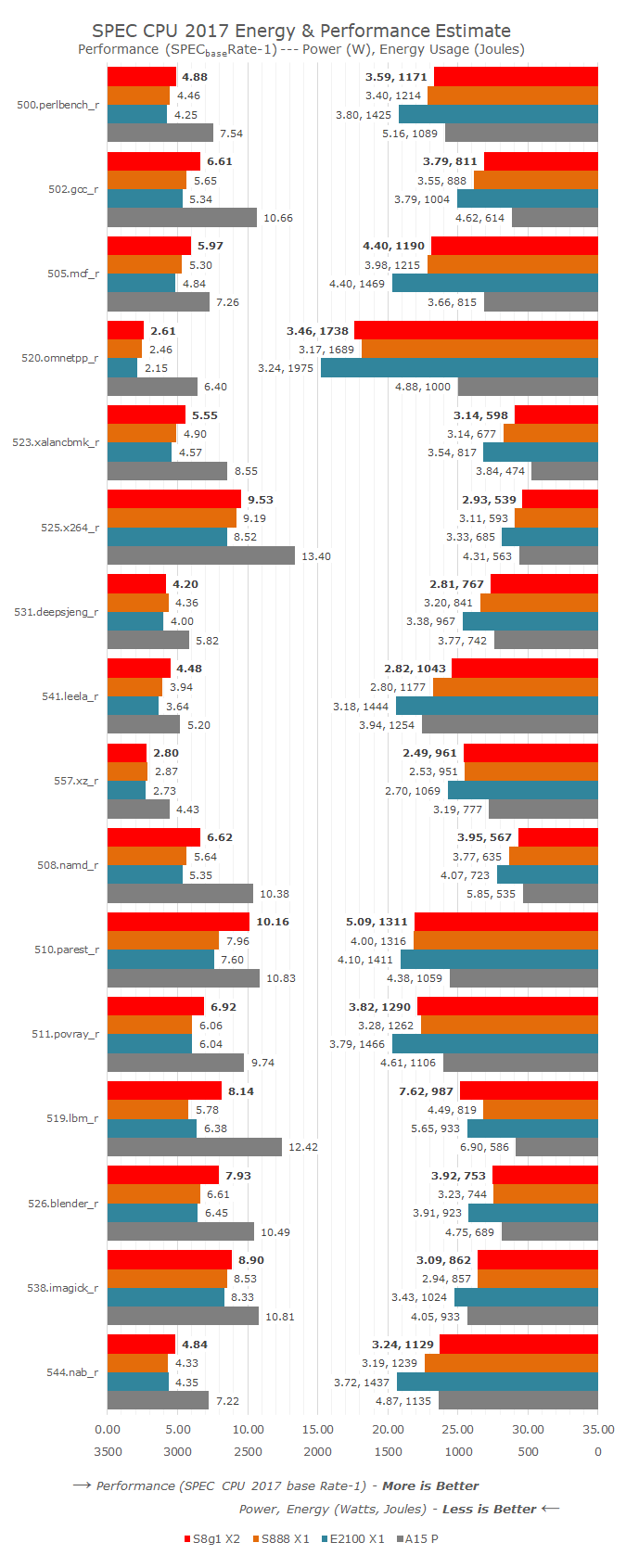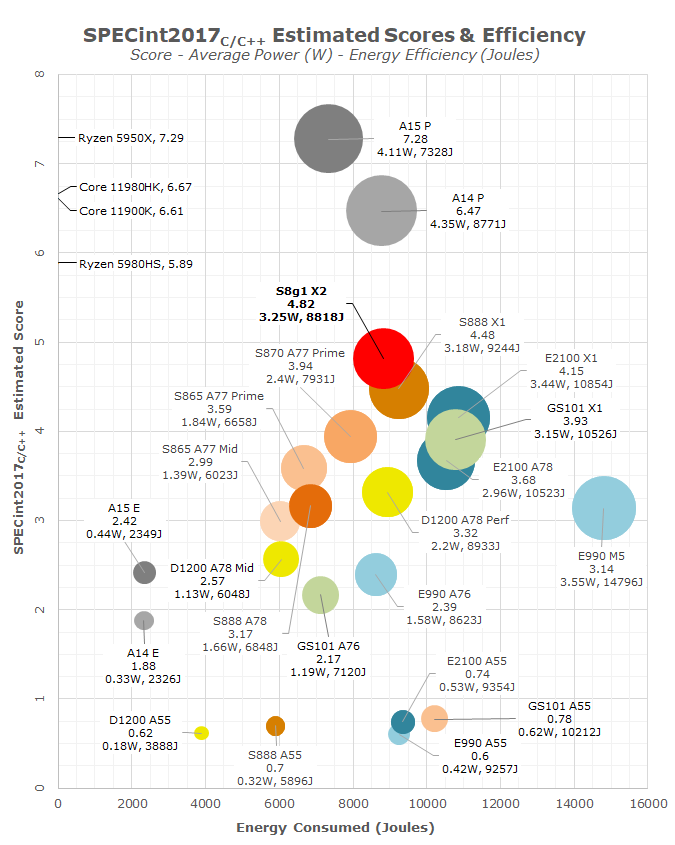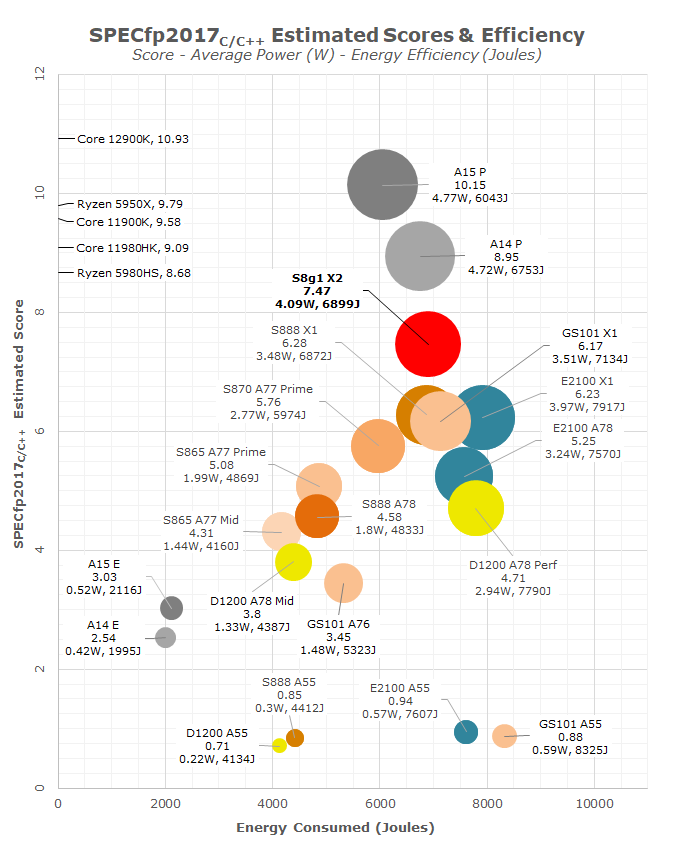The Snapdragon 8 Gen 1 Performance Preview: Sizing Up Cortex-X2
by Dr. Ian Cutress on December 14, 2021 8:00 AM ESTTesting the Cortex-X2: A New Android Flagship Core
Improving on the Cortex-X1 by switching to the Arm v9 architecture and increasing the core resources, both Arm and Qualcomm are keen to promote that the Cortex-X2 offers better performance and responsiveness than previous CPU cores. The small frequency bump from 2.85 GHz to 3.00 GHz will add some of that performance, however the question is always if the new manufacturing process coupled with the frequency increase allows for better power efficiency when running these workloads. Our standard analysis tool here is SPEC2017.
Running through some of these numbers, there are healthy gains to the core, and almost everything has a performance lift.
On the integer side (from 500.perlbench to 557.xr), there are good gains for gcc (+17%), mcf (+13%), xalancbmk (+13%), and leela (+14%), leading to an overall +8% improvement. Most of these integer tests involve cache movement and throughput, and usually gains in sub-tests like gcc can help a wide range of regular user workloads.
Looking at power and energy for the integer benchmarks, we’re seeing the X2 consume more instantaneous power on almost all the tests, but the efficiency is kicking in. That overall 8% performance gain is taking 5% less total energy, but on average requires 2% more peak power.
If we put this core up against all the other performance cores we test, we see that 8% jump in performance for 5% less energy used, and the X2 stands well above the X1 cores of the previous generation, especially those in non-Snapdragon processors. There is still a fundamental step needed to reach the Apple cores, even the previous-generation A14 performance core, which scores 34% higher for the same energy consumed (albeit on average another 34% peak power).
Just on these numbers, Qualcomm’s +20% performance or +30% efficiency doesn’t bare fruit, but the floating point numbers are significantly different.
Several benchmarks in 2017fp are substantially higher on the X2 this generation. +17% on namd for example would point to execution performance increases, but +28% in parest, +41% in lbm and +20% in blender showcases a mix of execution performance and memory performance. Overall we’re seeing +19% performance, which is nearer Qualcomm’s 20% mark. Note that this comes with an almost identical amount of energy consumed relative to the X1 core in the S888, with a difference of just 0.2%.
The major difference however is the average power consumed. For example, our biggest single test gain in 519.lbm is +41%, but where the S888 averages 4.49 watts, the new X2 core averages 7.62 watts. That’s a 70% increase in instantaneous power consumer, and realistically no single core in a modern smartphone should draw that much power. The reason why the power goes this high is because lbm leverages the memory subsystem, especially that 6 MiB L3 cache and relies on the 4 MiB system level cache, all of which consumes power. Overall in the lbm test, the +41% performance costs +20% energy, so efficiency is still +16% in this test. Some of the other tests, such as parest and blender, also follow this pattern.
Comparing against the competition, the X2 core does make a better generation jump when it comes to floating point performance. It will be interesting to see how other processors enable the X2 core, especially MTK’s flagship at slightly higher frequency, on TSMC N4, but also if it has access to a full 14 MiB combination of caches as we suspect, that could bring the power draw during single core use a lot higher. It will be difficult to tease out exactly who wins what where based on implementation vs. process node, but it will be a fun comparison to make when we look purely at the X2 vs. X2 cores.
Unfortunately due to how long SPEC takes to run (1h30 on the X2), we were unable to test on the A710/A510. We’ll have to wait to see when we get a retail unit.













169 Comments
View All Comments
Reflex - Tuesday, December 21, 2021 - link
Because Lineage's security model is completely broken. It's fun to play with on very old devices but I'd never put it on a device with access to anything I cared about.iphonebestgamephone - Tuesday, December 21, 2021 - link
What exactly? How is it any different from stock roms?Mujeeb - Tuesday, December 14, 2021 - link
U have to be kidding right. iPhone se might be costing just $400 in US but surely not outside US. Outside US, it costs $500.At $500 one gets a pure andriod flagship here in India. And in sale days, we get them further $100 cheap.
Let's compare (in India):
iPhone se $500 vs Xiaomi mi 11x
A13 (GB score 3400) vs Sd 870 GB score 3400)
Genshin Impact 53 fps vs 48 fps
PUBG 90 fps vs 60 fps
Amoled fhd+ 10 bit 120hz vs ips sd 60hz
Bigger display 6.6 inch vs 4.7
Battery 5000 mah vs 1800 mah
8gb ram 128 GB storage vs 3 gb ram and 64 gb storage
33w fast charging vs slowing charging
5g ready vs backward 4g
Modern minimalistic design vs old boring design
Punch hole vs old boring design
Peak brightness 1100 nits vs 480 nits
Camera 64 mp main vs 12 MP main
........
Oh God please don't force me to tarnish this so called se edition here.
Only ones who will prefer this are losers who think owning an apple mobile makes them richer.
1_rick - Tuesday, December 14, 2021 - link
"Only ones who will prefer this are losers who think owning an apple mobile makes them richer."Don't forget about the tiny hands brigade of twentysomethings with perfect eyes. They like their small screens, too.
Fulljack - Tuesday, December 14, 2021 - link
or people who just prefer small screen, tho.isthisavailable - Wednesday, December 15, 2021 - link
lol this is such a boomer commentReflex - Wednesday, December 15, 2021 - link
I'm not saying Android sucks or trying to start a flame war. But that Android phone you mention comes with between 2-3 years of support before you are on your own, with all the security risks that entails and slow loss of app compat.Meanwhile the iPhone 6S, released six years ago, just got iOS 15 which guarantees it at least four more years of support and all apps continue to function on it. A six year old phone will have a more functional lifespan than your brand new Xiaomi.
For someone trying to get into a phone cheap, have it just work, and who does not have an interest in upgrading (and spending another $400+) every 2-3 years, Apple is dirt cheap comparatively with 3-5x the support lifecycle for only 1.25x more money (using your comparison).
It's a no-brainer. Again, for those who aren't interested in the upgrade treadmill.
flyingpants265 - Thursday, December 16, 2021 - link
Well, every phone I've used from Android has cost less than $250 so at least it's not as bad as buying a new Galaxy phone every 2 years.flyingpants265 - Thursday, December 16, 2021 - link
I'm lying because I'm including used phones in this. I bought a lot of used LGs, they drop in value like rocks. There's an LG G7 selling locally right now for $80......Maybe buying a brand new phone is for suckers.
Reflex - Friday, December 17, 2021 - link
I don't generally recommend a new phone period, but again on Android that lack of support lifecycle is a problem as used cuts significantly into the support timeframe.